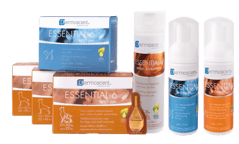
Seborrhea in companion animals
Seborrhea is a common dermatological disorder in companion animals, primarily affecting dogs and, less frequently, cats. It manifests as an abnormal production of sebum, leading to excessive scaling, greasiness, and, in some cases, secondary infections. The condition can be classified as either primary (idiopathic seborrhea) or secondary seborrhea, which arises due to an underlying pathology such as allergies, endocrine disorders, or infections. Recognizing and managing seborrhea effectively is essential to improving the quality of life for affected animals and minimizing complications such as pruritus, pyoderma, and chronic dermatopathies.
Clinical Presentation & Symptoms
Seborrhea may present in two primary forms:
- Seborrhea sicca (dry seborrhea): Characterized by excessive scaling, flaky skin, and a dry coat.
- Seborrhea oleosa (oily seborrhea): Involves excessive sebum production, greasy fur, and an unpleasant odor, often accompanied by secondary microbial overgrowth.
Key clinical signs:
- Excessive dandruff and flaky skin (most commonly seen on the back, face, and flanks)
- Greasy coat with a rancid odor
- Thickened, crusty, or inflamed skin
- Increased pruritus and scratching
- Hyperpigmentation and lichenification in chronic cases
- Secondary bacterial or Malassezia infections
Types of Seborrhea and Predisposing Factors
Two different types of seborrhea exists in companion animals.
Primary Seborrhea (Idiopathic)
- Genetic condition, often diagnosed in young animals
- Common in breeds such as Cocker Spaniels, West Highland White Terriers, English Springer Spaniels, and Basset Hounds
Secondary Seborrhea (Most common form)
- Allergic dermatitis: Atopic dermatitis or food allergies
- Endocrine disorders: Hypothyroidism, hyperadrenocorticism
- Parasitic infections: Fleas, Demodex mites, or Cheyletiella
- Microbial overgrowth: Staphylococcal pyoderma or Malassezia dermatitis Nutritional deficiencies: Lack of omega-3 fatty acids, vitamin A, or zinc
- Environmental factors: Dry climates, over-bathing with harsh shampoos
Diagnostic workup for Seborrhea
A thorough diagnostic workup is essential to determine whether seborrhea is primary or secondary. Diagnostic tests should include:
- Comprehensive history & clinical examination (assess breed predisposition, onset, and severity)
- Skin cytology (evaluate for bacteria, yeast, and inflammatory cells)
- Skin scrapings (rule out ectoparasites)
- Fungal cultures & Wood’s lamp examination (detect dermatophytosis)
- Bloodwork & endocrine testing (thyroid panel, ACTH stimulation test)
- Skin biopsy (in refractory or unclear cases)
Treatment Strategies & Management of Seborrhea
Successful management of seborrhea requires a multimodal approach, combining topical therapy, systemic treatments (if needed), and nutritional support.
Medicated shampoos, sprays, and mousse formulations play a crucial role in controlling seborrhea, reducing microbial overgrowth, and restoring skin homeostasis by:
- Reduce excessive scaling and control sebum production
- Hydrate and restore the skin barrier function
- Minimize microbial proliferation and secondary infections
- Promote long-term dermatological health
Product selection for Seborrhea
When dealing with seborrhea in pets, having the right products readily available can help regulate sebum production, reduce flaking, and support overall skin health. Here are the products to keep on hand:
Zincoseb
...is a specialized dermatological formulation designed to support the management of seborrhea in dogs and cats. Available in shampoo and foam, its unique combination of zinc gluconate, salicylic acid, and sulfur works synergistically to regulate sebum production, diminish excessive scaling, and restore the skin’s natural barrier. This targeted approach not only helps to address the signs of seborrhea but also minimizes the risk of secondary infections.
Dermoscent® Essential 6 range

...is a scientifically formulated line designed to support skin health in dogs and cats, particularly those with seborrheic disorders. These products provide essential fatty acids, natural plant extracts, and antioxidants to help restore the skin’s hydrolipidic barrier, regulate sebum production, and reduce flaking. Available in shampoo, mousse and spot-on.
